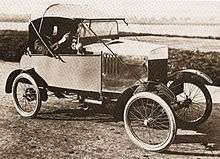Grahame-White
Grahame-White was an early British aircraft manufacturer, flying school and later manufacturer of cyclecars.
The company was established as Grahame-White Aviation Company by Claude Grahame-White at Hendon in 1911. The firm built mostly aircraft of its own design, including the successful Type XV, but during World War I produced Morane-Saulnier types under licence for the British military. The company ceased aircraft manufacturing operations in 1920.
In the same year the company was renamed Grahame-White Company Ltd. and manufactured cyclecars until 1924. From 1920 onwards a very basic two-seat 3.3 hp type with air-cooled single-cylinder engine of 348 cc capacity was offered. It had a two-speed transmission with final chain drive. The car had quarter elliptical spring suspension front and rear as well as flex in the wood frame and seat cushions.[1] In 1921 a 7 hp type with a Coventry-Victor twin-cylinder engine (capacity: 689 cc) and friction drive was added for one year only followed in 1924 by a four-cylinder 10 hp type with a Dorman engine of 1,094 cc, but very few were made.[1] The final Angus-Sanderson cars were also made in the factory.[1]
Grahame-White ceased its operations completely in 1924.
Aircraft
- Grahame-White Baby
- Grahame-White Type VI
- Grahame-White Type VII Popular
- Grahame-White Type X Charabanc
- Grahame-White Type XI
- Grahame-White Type XIII Circuit of Britain biplane/scout
- Grahame-White Type XV
- Grahame-White Type 18
- Grahame-White G.W.19 (License-built Breguet Bre.5)
- Grahame-White Type 20 Scout (Prototype only)
- Grahame-White Type 21 Scout (Prototype only)
- Grahame-White Ganymede
- Grahame-White G.W.E.7
- Grahame-White Bantam
Cyclecars

| Model | Years | No. of Cylinders | Capacity | Wheelbase |
|---|---|---|---|---|
| 3.3 hp | 1920–1924 | 1 | 348 cc | 6' 5" |
| 7 hp | 1921 | straight-2 | 689 cc | 8' 1" |
| 10 hp | 1924 | straight-4 | 1094 cc | 8' 1" |
References
- Baldwin, N. (1994). A-Z of Cars of the 1920s. Devon, UK: Bay View Books. ISBN 1-870979-53-2.
- Gunston, Bill (2005). World Encyclopedia of Aircraft Manufacturers. Annapolis: The History Press Ltd; 2Rev Ed edition. p. 132. ISBN 978-0750939812.
- Jane's All the World's Aircraft 1919. London: Sampson, Low, Marston. p. 140.
- Culshaw, David & Horrobin, Peter (1997). The Complete Catalogue of British Cars 1895–1975. Dorchester: Veloce Publishing plc. pp. 398–399. ISBN 1-874105-93-6.